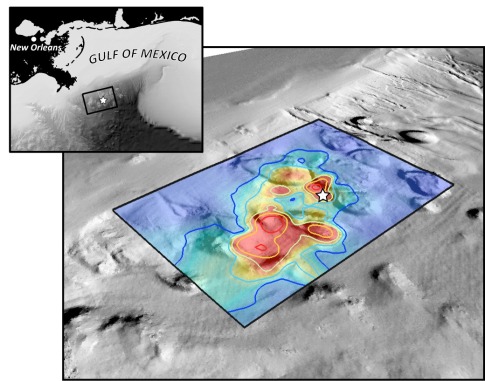– Oil Residue The Size Of Rhode Island Covers Gulf Of Mexico Seafloor In Macondo Well Disaster Aftermath (ZeroHedge, Oct 29, 2014):
Ever since the April 2010 disaster on the BP-operated Macondo well in the Gulf of Mexico, there was one big outstanding question: where did the bulk of the oil gol? Now, thanks to a research team led by David Valentine, a microbial geochemist at the University of California, Santa Barbara, sampled more than 534 locations near the spill site, gathering more than 3,000 individual samples, we know the answer: the oil spill – some 10 million gallons of coagulated oil – left an oily “bathub ring” on the sea floor of the Gulf of Mexico, about 25 miles from the well, that’s about the size of Rhode Island.
The researchers found an area of 1,250 square miles (3,237 square km), mostly southwest of the Macondo well, where a thin sheen of oil rests in patches on the top half-inch of the seafloor, according to the NSF.
The reason why the massive spill was never visible on the ocean surface? “Based on the evidence, our findings suggest that these deposits are from Macondo oil that was first suspended in the deep ocean, then settled to the seafloor without ever reaching the ocean surface,” Valentine said in the statement.
“This analysis provides us with, for the first time, some closure on the question, ‘Where did the oil go, and how did it get there?'” Don Rice, the program director of the National Science Foundation’s Division of Ocean Sciences, told Live Science in a statement.
More from Live Science:
The droplets of oil started out 3,500 feet (1,067 meters) below the ocean surface and were caught by deep-ocean currents before raining down another 1,000 feet (305 m) to the seafloor, Valentine said. This hydrocarbon rain explains the damage suffered by coral around the site, he said.
“The pattern of contamination we observe is fully consistent with the Deepwater Horizon event but not with natural seeps,” Valentine said.
Unfortunately, there is more: a major portion of the spill has still not be accounted for and much of the deep ocean oil is still missing. The portion Valentine and his colleagues traced represents only 4 to 31 percent of the oil thought to be trapped in the depths of the ocean (up to 16 percent of the total oil spilled).
AP adds that according to Valentine the spill from the Macondo well left other splotches containing even more oil. He said it is obvious where the oil is from, even though there were no chemical signature tests because over time the oil has degraded.
“There’s this sort of ring where you see around the Macondo well where the concentrations are elevated,” Valentine said. The study, published in Monday’s Proceedings of the National Academy of Sciences, calls it a “bathtub ring.”
Oil levels inside the ring were as much as 10,000 times higher than outside the 1,200-square-mile ring, Valentine said. A chemical component of the oil was found on the sea floor, anywhere from two-thirds of a mile to a mile below the surface.
The rig blew on April 20, 2010, and spewed 172 million gallons of oil into the Gulf through the summer. Scientists are still trying to figure where all the oil went and what effects it had.
Needless to say, BP is not enthused and hardly wants this walk down memory lane recreated which is why the oil giant questioned the conclusions of the study. In an email, spokesman Jason Ryan said, “the authors failed to identify the source of the oil, leading them to grossly overstate the amount of residual Macondo oil on the sea floor and the geographic area in which it is found.”
It’s impossible at this point to do such chemical analysis, said Valentine and study co-author Christopher Reddy, a marine chemist at Woods Hole Oceanographic Institute, but all other evidence, including the depth of the oil, the way it laid out, the distance from the well, directly point to the BP rig.
And, of course, there is the logical question: who else had a massive oil spill in the GOM in recent years?
And while some of the oil has been found, the question where the rest is remains, as does the far more important question: what was the spill’s impact on sealife and sea-currents in the Gulf? At least several more years will have to pass before that particular answer is unveiled.
